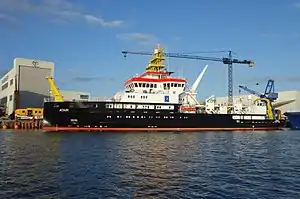RV Atair
RV Atair is a research vessel owned and operated by the Federal Maritime and Hydrographic Agency of Germany (BSH). She is expected to enter service in late 2020 and replaces a 1987-built research vessel also named Atair.
 Atair near completion at Fassmer Werft | |
| History | |
|---|---|
| Name: | RV Atair |
| Owner: | Federal Maritime and Hydrographic Agency of Germany |
| Operator: | Federal Maritime and Hydrographic Agency of Germany |
| Port of registry: |
|
| Builder: | Fassmer Werft and German Naval Yards |
| Cost: | €113.8 million |
| Laid down: | December 2017 |
| Launched: | February 2019 |
| Identification: | IMO number: 9835496 |
| General characteristics | |
| Class and type: | Research vessel |
| Length: | 85 m (279 ft) |
| Beam: | 16.8 m (55 ft) |
| Draft: | 5 m (16 ft) |
| Installed power: | Wärtsilä dual fuel |
| Speed: | 13 knots (24 km/h) |
| Crew: |
|
History
BSH issued a request for proposals for a new research vessel in October 2014, and completed design work for the ship early in 2015.[1] The ship was originally planned to have a cost of about €80 million and enter service late in the decade.[1] The €113.8 million contract for overall engineering and construction of the ship was awarded to Kongsberg.[2] Construction of Atair was sub-contracted to two German shipyards—Fassmer Werft and German Naval Yards (GNY).[3] Construction began in December 2017,[4] and the hull and superstructure were launched at German Naval Yards in February 2019.[3] Following some fitting out work, including the installation of the main powerplants, Atair was transported to Fassmer Werft the following month to be completed.[3] Sea trials began in late 2019 and continued through September 2020 ahead of the expected delivery of Atair late in 2020.[3][5][6] Upon her entry into service for BSH, which will own and operate Atair, she will replace the 1987-built Atair and operate primarily in the Baltic Sea, the North Sea, and the North Atlantic Ocean.[5][2]
Design
Atair measures 75 metres (246 ft) long, 16.8 metres (55 ft) wide, and has a draft of 5 metres (16 ft).[3] She is powered by three Wärtsilä engines, two of which are LNG-capable, that give her a service speed of up to 13 knots (24 km/h) through a single propeller.[3] Atair is the first research vessel in the world to have an LNG-fueled propulsion system.[1] The crew complement is 18 sailors, with accommodations for up to 15 researchers.[2] Scientific facilities on board include several types of sonar, laboratories, rigging to support the deployment of off-vessel equipment, and deck space to house additional temporary equipment.[2]
References
- "'Atair' bids under study". Maritime Journal. 22 May 2015. Retrieved 16 August 2020.
- "Atair II Research Vessel". Ship Technology. Retrieved 16 August 2020.
- "German LNG research newbuild is on track". The Motorship. 13 March 2019. Retrieved 16 August 2020.
- "Construction under way on pioneering LNG research ship". Baird Maritime. 13 February 2018. Retrieved 16 August 2020.
- "Germany Prepares to Commission World's First LNG-Powered Research Ship". The Maritime Executive. 7 August 2020. Retrieved 16 August 2020.
- "Sea trials completed for Germany's newest hydrographic ship". Baird Maritime. 7 September 2020. Retrieved 21 October 2020.
| Wikimedia Commons has media related to IMO 9835496. |